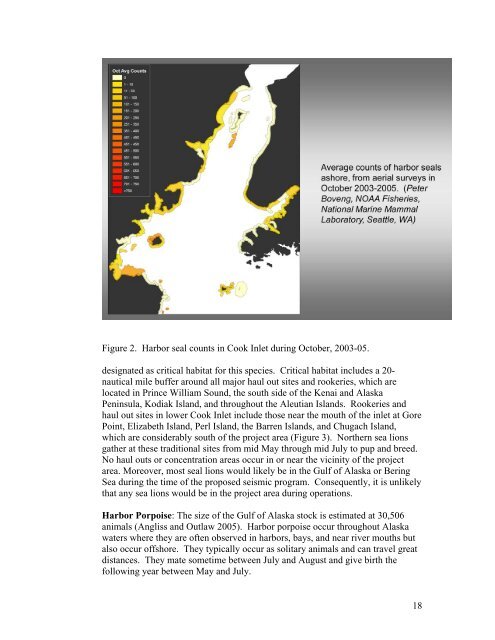IHA Application: Seismic Surveys in Cook Inlet by Marathon Oil ...
IHA Application: Seismic Surveys in Cook Inlet by Marathon Oil ...
IHA Application: Seismic Surveys in Cook Inlet by Marathon Oil ...
Create successful ePaper yourself
Turn your PDF publications into a flip-book with our unique Google optimized e-Paper software.
Figure 2. Harbor seal counts <strong>in</strong> <strong>Cook</strong> <strong>Inlet</strong> dur<strong>in</strong>g October, 2003-05.<br />
designated as critical habitat for this species. Critical habitat <strong>in</strong>cludes a 20nautical<br />
mile buffer around all major haul out sites and rookeries, which are<br />
located <strong>in</strong> Pr<strong>in</strong>ce William Sound, the south side of the Kenai and Alaska<br />
Pen<strong>in</strong>sula, Kodiak Island, and throughout the Aleutian Islands. Rookeries and<br />
haul out sites <strong>in</strong> lower <strong>Cook</strong> <strong>Inlet</strong> <strong>in</strong>clude those near the mouth of the <strong>in</strong>let at Gore<br />
Po<strong>in</strong>t, Elizabeth Island, Perl Island, the Barren Islands, and Chugach Island,<br />
which are considerably south of the project area (Figure 3). Northern sea lions<br />
gather at these traditional sites from mid May through mid July to pup and breed.<br />
No haul outs or concentration areas occur <strong>in</strong> or near the vic<strong>in</strong>ity of the project<br />
area. Moreover, most seal lions would likely be <strong>in</strong> the Gulf of Alaska or Ber<strong>in</strong>g<br />
Sea dur<strong>in</strong>g the time of the proposed seismic program. Consequently, it is unlikely<br />
that any sea lions would be <strong>in</strong> the project area dur<strong>in</strong>g operations.<br />
Harbor Porpoise: The size of the Gulf of Alaska stock is estimated at 30,506<br />
animals (Angliss and Outlaw 2005). Harbor porpoise occur throughout Alaska<br />
waters where they are often observed <strong>in</strong> harbors, bays, and near river mouths but<br />
also occur offshore. They typically occur as solitary animals and can travel great<br />
distances. They mate sometime between July and August and give birth the<br />
follow<strong>in</strong>g year between May and July.<br />
18
















